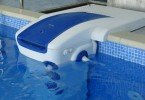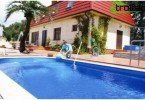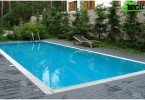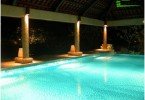Do-it-yourself pool filter
Sooner or later, every owner of the pool faces an important issue related to the quality content of water, which largely depends on the right choice of filter. There are many companies ready to implement this task, but you need to be prepared for the fact that it will cost quite a substantial amount. Much more promising is the opportunity to independently make a filter for the pool with your own hands. However, in order to do this as best as possible, it will not be superfluous to deal with all existing pollutants and classify them.
Content
- Water pollutants and ways to deal with them
- Types of filters for pools
- Homemade Floating Filter
Water pollutants and ways to deal with them
The main problem of any outdoor pool is surface pollution, which is caused by falling dust, pollen of plants, bird droppings, grass, leaves, etc. onto the water surface. Most of these pollutants are removed mechanically using a net, but it is also possible to solve the problem by installing a garbage overflow in the pool. No matter how quickly the garbage is removed, but still part of it will surely dissolve and remain in the water column, which itself contains many microorganisms and algae.
And if you add light and heat in sufficient quantities here, then without taking more radical measures, the water will certainly bloom. When depleted in water substances useful for the development of algae, a decrease in the amount of light and a decrease in temperature, algae die and sink in the form of bottom contaminants. In addition, undissolved garbage contributes to the formation of bottom contaminants, when it is heavier than water.
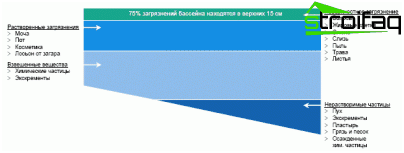
Features of the distribution of pollution
To combat each of the contaminants, there are cleaning methods. With the help of chemicals alone, the problem cannot be solved, and if it is possible to cope with flowering, then mechanical pollution can only be overcome mechanically.
Pollutants are removed from the pool surface by overflow or net, from the bottom – a special water “vacuum cleaner”, but the water column can be cleaned only by filtering the water. To do this, you need to arrange a water intake in one place of the pool, from which water will be pumped with a pump, passed through the filter elements and again returned to the pool.
Types of filters for pools
In pools, three types of filters are used – sand, earthen and cartridge. Sand filters are the least effective, but at the same time the most popular due to their low cost..

The simplest filter is sand
They are large tanks filled with special sand for pools through which water is filtered. Trapped dirt accumulates around the edges of the sand filter. It is capable of retaining particles of about 20 microns in size and keeping most of the pool relatively clean. The main inconvenience of the sand filter is its fast clogging, as a result of which it is necessary to carry out weekly cleaning using a reverse flow, which leads to a significant increase in water consumption.
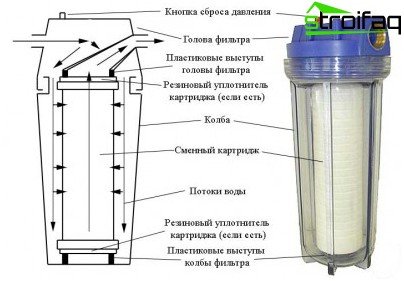
Cartridge Filter Block Diagram
The cartridge filter is a container in which 3-4 cylindrical cartridges are located. A material visually resembling polyester retains particles up to 5-10 microns in size. In service, this filter is quite simple – the cartridges can be removed and washed with water under pressure or cleaned using a special cleaning solution. In the end, the cartridge can simply be replaced.
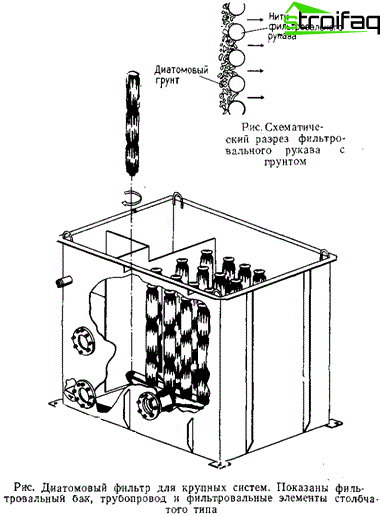
Diatom earthen filter
The most expensive, and therefore most reliable, is a diatom earthen filter, which consists of hundreds of millions of particles of fossil plankton. A filter device for a pool of this kind perfectly captures the smallest particles of 3-4 microns in size and holds them. Most of these filters require cleaning with a reverse water flow, but this procedure may not be enough. In this case, it will be necessary to replace the diatom mixture, but this can be problematic, since the spent composition is classified as “hazardous waste” and special disposal will be required.
Homemade Floating Filter
Answering the question of how to make a filter for the pool yourself is quite simple, if you look at a primitive filtering unit worth up to $ 120, which consists of a cartridge and a pump. To ensure quality pool cleaning It is important to place water intake and discharge sites as far as possible from each other. In our case, the installation is supposed to be buoyant and this requirement is not relevant, since the filter will be constantly in motion.
Typically, the diameter of a simple replaceable cartridge is 50 mm, so we need a cartridge and a 2-3 meter polypropylene pipe of the same diameter. The length of the pipe depends on the capacity of the pump, which is selected in accordance with the volume of the pool. Still need an angular “rotation” of the same material with a diameter of 50 mm and a piece of a threaded rod M12. In the case of using a longer pin, several cartridges can be used simultaneously, which will significantly improve the quality of cleaning, but a much more powerful pump will be required. In the plug and turn, you need to drill a hole into which to pass the stud and fix the structure with a nut.
A pump should be connected to the other side of the pipe, the power of which is determined by the need for filtration. For a pool of 250-300 cubic meters, a pump with a capacity of 25-30 W is enough, with a capacity of about 2500 liters per hour. In order for the structure to stay on water, the ends of the tube must be tightly closed, for which expanded polystyrene is ideal. Water is sucked into the pump at a depth of about 50-60 cm, then there is pumping through the pipe and getting into the cartridge. The purified water immediately returns to the pool. This design is also attractive because no pipes and hoses are required to connect to outlets and water intakes..
Despite not very high performance, a homemade pool filter significantly improves water quality. Since only one filter cartridge is installed, it requires regular cleaning at least once a day. To do this is quite simple – just remove the rotation of the pipe and remove the filter cartridge. In order to prevent accumulated debris and dirty water from getting into the pool again, before removing it is necessary to “place” a plastic container under the filter, for which you can use a regular bucket. After removing the filter cartridge, you just need to rinse it under a running stream and reinstall it. On this, the service mission can be considered completed – the whole procedure does not take more than two to three minutes.
It is quite obvious that an ordinary plastic pipe floating on the surface of your pool has a fairly unpresentable appearance. If you are satisfied with the work of your filter, you can think about aesthetics and mask the design of the filtration system under a sheet of water lily, a floating island or give it the shape of a canoe. Here you can already show all your imagination and ingenuity..
If you look at the cost of the manufactured installation, it will become obvious that its price will be several times lower than the proposed similar design. Parts for its manufacture can be purchased at any hardware store, and a pump of the required capacity can be purchased at a pet store specializing in aquarium equipment. Filter cartridges can be bought at the supermarket or made independently from non-woven material or foam. When all materials are at hand, you can assemble the structure and put it into operation even in the absence of the necessary skills within one hour.
Despite the fact that the sand filter is the cheapest, yet its manufacture is more time-consuming – special tools and materials are needed.
Of course, you can make a good sand filter yourself, but it is unlikely that in this case it will be possible to achieve the desired economic effect. Even if in the end the cost of a makeshift filter is slightly lower than the finished design, still it will take a lot of effort to make it. When using metal structures, you will need a welding machine and skills to work with it, and for working with polypropylene and plastic – special equipment or a set of fittings.
Nevertheless, the floating design presented, although it seems a bit rustic, but makes it possible to achieve the desired result in the form of clean water in the pool.


